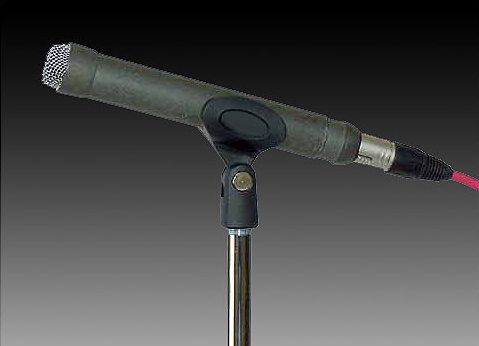A LESSON IN MIC SELECTION

ElectroVoice RE654a
Let me tell you a funny little story from my professional past that illustrates a point about mics: Back in the mists of time when dinosaurs roamed the earth, consoles were ten feet long, and recording was done onto rusty polyester tape, I took a job as a recording engineer at a broadcast company that had a weekly in-house employee meeting. After a live morning show, a TV studio was set up to accommodate five hundred employees with PA support and feeds were established to the affiliate TV stations, and the meeting was videotaped for distribution to the employees overseas. Every week, a different amateur band with a full drum kit and up to ten members would arrive a half-hour before the meeting and set up in the studio. In rotation, a different audio engineer from the staff was assigned to the project. He had only that half-hour to get set up and set the monitors, often without a second engineer. At that point his mix went live to the various audiences.
Adding to the stress on the mixer, the ten other audio engineers on staff were listening to the mix in various locations in the building. If you screwed up the tiniest little bit someone would usually call within seconds and gleefully give you a good-natured razzing. "I can't hear the congas!" Your famous screw-up became the water cooler joke of the week in the audio department. This atmosphere led to each person developing a quick setup and selection of mics and competing for the best mix. We'd study Mix Magazine and Recording Engineer & Producer (RIP) magazines for the latest techniques and pilfer each other's methods. We were all newly-minted engineers full of spit and vinegar and it was a great pressure cooker to develop our skills. I began to love the challenge whenever I was assigned. At that point in time my company had a choice of about one hundred mics to do the job. There were really good mics, pretty good mics, pretty average mics, and beat-up old mics left over from other eras that no-one knew much about or wanted to monkey with.
One day, the engineer on this duty got this GREAT kick drum sound on the drum kit that turned all of our heads. Of course, being young, driven professionals, each of us had to tiptoe down to the studio, act disinterested, and surreptitiously catch a glance at the kick drum. This guy, however, had pulled a fast one on us all and had covered it up with a towel. That forced us to play our hands and ask what he used! It turns out that he had been fiddling with the ancient, crusty old mics and found a use for one we had all ignored, a beat-up old cigar-shaped omni thing. In fact, it was the ugliest, most beat-up, encrustulated mic in the bunch of old left-overs. It appeared to be on its last legs. As each of us engineers came on staff and began digging through the mic closets, he would come upon this one, hold it up at arm's length between thumb and forefinger like a dead fish, and think, "I will never, ever, be caught using this thing in a set up." It was an ElectroVoice RE654A small diaphragm dynamic omni from the 1960s. No-one had considered a small diaphragm mic or an omni-directional mic for a kick mic. At that point, the trend was towards large diaphragm cardioids. As it turned out, because the mic was inside the shell of the drum, the pattern wasn’t much of a factor and the mic’s lack of cardioid proximity boost meant it put out a great, balanced sound with lots of “click.” By his little exercise this engineer taught us all some real lessons: never, ever, put a mic in a box and think it can be used for only one application. Never, ever, allow yourself to get comfortable with a single setup and exclude possibilities that might improve your sound. Keep as many options in your mental rolodex as possible in case you end up in need with a limited selection of mics.
With that lesson under our belt, we were further along on our way to understanding the story about the old engineer:
A young cretin engineer asks an old engineer, "Which is the best mic, A, B, or C?" The old engineer scratches his head, thinks, and replies, "For what?" Frustrated, the young engineer asks the old engineer, "Which is the best mic for mic'ing an acoustic guitar, A, B, or C?" "Ah!" says the old engineer, knowingly. He scratches his head, thinks deeply, and replies, "It depends." Then he walks away.
There is no best, there is only what works.
= =
=

